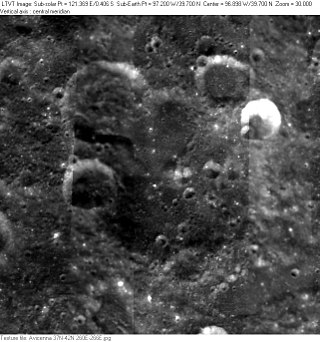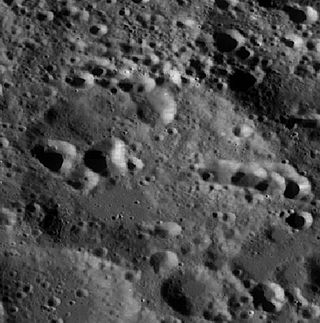
Alter is a lunar impact crater that is located in the northern hemisphere on the far side of the Moon. It lies to the southwest of the larger crater Robertson, and to the east of Ohm.

Maginus is an ancient lunar impact crater located in the southern highlands to the southeast of the prominent crater Tycho. It is a large formation almost three quarters the diameter of Clavius, which lies to the southwest. Just to the north of Maginus is the smaller crater Proctor, and to the southeast is Deluc.

Faraday is a lunar impact crater in the southern highlands of the Moon. It was named after British chemist and physicist Michael Faraday. It lies across the southeast rim of the larger crater Stöfler, and the northwest rim of Faraday forms a wide rampart across the otherwise flat floor of Stöfler. To the east of Faraday is Maurolycus.

Cleomedes is a prominent lunar impact crater located in the northeast part of the visible Moon, to the north of Mare Crisium. It was named after Greek astronomer Cleomedes. It is surrounded by rough ground with multiple crater impacts. The irregular crater Tralles intrudes into the northwest rim. To the east is Delmotte. North of Cleomedes is a triple-crater formation with Burckhardt occupying the center.

Cavendish is a lunar impact crater that is located in the southwest part of the Moon, to the southwest of the larger crater Mersenius. It lies between the smaller craters Henry to the west-northwest and de Gasparis to the east-southeast.

Gutenberg is a lunar impact crater that lies along the west edge of Mare Fecunditatis, in the eastern part of the visible Moon. It is named after German inventor Johannes Gutenberg. To the southeast are the craters Goclenius, Magelhaens and Colombo. To the west-southwest is the crater Gaudibert, across the Montes Pyrenaeus that run south from Gutenberg.

Barocius is an ancient lunar impact crater that is located in the rugged southern highlands of the Moon. It was named after Italian mathematician Francesco Barozzi. It lies just to the southeast of the large crater Maurolycus. To the southwest of Barocius is Clairaut, and to the south-southeast lies Breislak.

Avicenna is a lunar impact crater that lies on the far side of the Moon, just beyond the western limb on the northern rim of the Lorentz basin. It is named after the Persian polymath Avicenna. It lies to the north-northwest of the larger crater Nernst, and to the southeast of Bragg.

Büsching is a lunar impact crater that is located in the crater-covered southern highlands of the Moon. It was named after German geographer Anton F. Büsching. The similar-sized crater Buch is located adjacent to its southwestern rim, and further to the southwest lies Maurolycus.

Biela is a lunar impact crater that is located in the rugged highlands of the southeastern Moon. It is named after Austrian astronomer Wilhelm von Biela. The crater lies to the east of Rosenberger, to the southeast of the Watt–Steinheil double crater.

Desargues is an ancient lunar impact crater that is located near the northern limb of the Moon, on the western hemisphere. It lies nearly due south of the crater Pascal, and southeast of Brianchon. The proximity of this crater to the limb means that it appears highly elongated due to foreshortening, and it is difficult to discern details from the Earth.

Barringer is a lunar impact crater that is located on the southern hemisphere on the Far side of the Moon, named after geologist Daniel Barringer. It is attached to the north-northeastern rim of the walled basin named Apollo, and lies to the southeast of Plummer. South of Barringer, on the floor of the Apollo basin, is the crater Scobee.

Gemma Frisius is a lunar impact crater that is located in the rugged southern highlands of the Moon. It was named after Dutch physician Gemma Frisius. It lies to the north of the walled plain Maurolycus, and southeast of the smaller crater Poisson. The crater Goodacre is attached to the northeast rim.

Clairaut is a lunar impact crater that is located in the rugged southern highlands of the Moon's near side. It lies directly to the south of the crater Maurolycus and southeast of Barocius. Just to the southwest is Cuvier.

Pasteur is a large lunar impact crater, approximately 233 kilometers in diameter, belonging to the category termed a walled plain. It was named after French chemist and microbiologist Louis Pasteur. It lies on the far side of the Moon as seen from the Earth, just beyond the eastern limb. The vicinity of this crater is occasionally brought into view from Earth due to librations, although not much detail can be seen.

Charlier is a lunar impact crater that is located on the far side of the Moon. To the south-southeast is the larger crater Kovalevskaya, and northeast of Charlier is Perrine.

Chandler is a lunar impact crater in the northern hemisphere, on the Moon's far side. It lies to the southeast of the large walled plain D'Alembert, and southeast of the slightly smaller Chernyshev crater.

Emden is a lunar impact crater that is located in the northern hemisphere on the far side of the Moon. It is named after Jacob Robert Emden (1862-1940).

Fersman is a large lunar impact crater on the Moon's far side. It lies to the east of the crater Poynting, and west-northwest of Weyl. To the south is the huge walled plain Hertzsprung.

Ramsay is a lunar impact crater that is located on the Moon's far side. It lies to the south-southwest of the larger crater Jules Verne, and is nearly in contact with the satellite crater Jules Verne P along the northern outer rim. To the southeast of Ramsay is the crater Koch, and to the west-southwest lies the overlapping pair of Roche and Pauli.






















